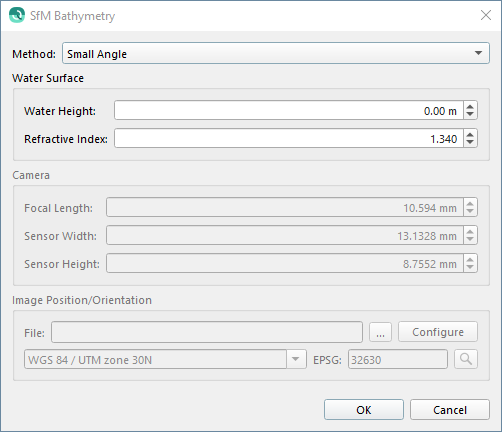Qimera Structure from Motion (SfM) Bathymetry Dialog

How to Start
After obtaining and activating a valid SfM Bathymetry license from QPS...
You can select SfM Correction... option of the Tools → Utilities sub-menu of the Main Menu toolbar.
What it Does
This dialog is used to correct for refraction errors in submerged data acquired from airborne photogrammetry, commonly referred to as "Structure from Motion", or SfM. This can be applied to Processed Point Files.
Because of the large density difference between air and water, light reflected off submerged objects and observed from the air will be significantly refracted. From an airborne camera's perspective the submerged objects will appear shoaler than they are in reality.
While the refraction correction is dependent on the angle of incidence with the water, with photogrammetry the exact angle of incidence of any given point is unknown because it is the combination of multiple camera positions. There are two methods available to estimate a correction. The Dietrich method tries to find all the camera positions or images that may have contributed to a point and averages the correction. The small angle approach does not remove all refraction errors, but removes a large error which is easy to model and correct for even with an unknown incidence angle.
This should not be used in conjunction with the Z-Shift Data filter (see Manage Filter Profiles) as it will remove any previously applied shifts.
General Description
The various settings for SfM Bathymetry tool are described below.
Method
Method | Description |
|---|---|
Dietrich | Camera properties are used to compute the field of view of each image. A point is refraction corrected for the incidence angle of each image for which it falls within the field of view. The final correction to a point is the average of all corrections. This is the preferred and default method. |
Small Angle | This method makes the assumption that all incidence angles are at or near perpendicular with the water surface, or in other words that they are small angles of incidence. For a downward facing camera with a horizontal field of view of 70 degrees the error due to refraction is between 25% and 32% of water depth. The default setting of 1.34 for the refractive index of water will account for between 100% of the refraction error at nadir (near the camera track) to 70% at the outer extents of the field of view (away from the camera track). This will account for the majority of the refraction error but will leave some of the data in the outer extents of the field of view shoal biased a maximum of 10% of water depth. For the same camera configuration a scale factor of 1.48 will overcorrect with 140% of the refraction error at nadir to 100% at the outer extents of the field of view. This will deep bias the data near the camera track up to 10% of water depth, but in some cases may be preferable for matching data at the edge of the aerial survey with acoustic derived bathymetry in deeper waters. Use if you do not have access to camera positions and orientations. |
Water Surface
This group of settings relates to describing the water surface and it's properties.
Water Height
This is the height of the water in your vertical datum when the data was acquired.
For example, if your data is referenced to mean sea level (MSL) and the tide was 1.0 meters below MSL during data acquisition then the water height should be entered as -1.0 meters.
Refractive Index
This is the refractive index for water with respect to air. This should generally not be modified unless you are using the Small Angle method and can accept some deep biasing of the data.
Camera
Focal Length, Sensor Width, and Sensor Height should be provided by the camera manufacturer or accessible within your SfM processing software. All values should be in millimeters. These are used to compute the field of view of the camera.
These settings are only applicable to the Dietrich method
Image Position/Orientation
These settings are only applicable to the Dietrich method and are required
File
This is the "Omega Phi Kappa" file export from you SfM software describing the image, or camera positions and orientations. You will have to configure the ASCII parser for the 6 required fields: X, Y, Z, Omega, Phi, and Kappa.
X, Y, and Z are easting, northing, and height, or longitude, latitude, and height respectively.
Omega, Phi, and Kappa are the rotations about the X, Y, and Z axes respectively. This is a convention specific to photogrammetry and is different from our standard rotation conventions.
Coordinate Reference System
This should be the coordinate reference system (CRS) of the positions in the file. This is required in order to relate the image positions with project data.
The default is the project CRS, which assumes there is no transform.
Return to: Qimera Interface
Return to: Wizards and Dialogs
